maintenance PORSCHE CAYNNE 2004 1.G Owners Manual
[x] Cancel search | Manufacturer: PORSCHE, Model Year: 2004, Model line: CAYENNE, Model: PORSCHE CAYENNE 2004 1.GPages: 379, PDF Size: 13.91 MB
Page 1 of 379

1
Dear Owner,We would like to thank you for your purchase of a
Porsche Cayenne. Judging by the car you have
chosen, you are a motorist of a special breed, and
you are probably no novice when it comes to
automobiles.
Remember however, as with any vehicle, you
should take time to familiarize yourself with your
Porsche and its performance characteristics.
Always drive within your own unique capabilities as
a driver and your level of experience with your
Porsche. Ensure that anyone else driving your
Porsche does the same. To prevent or minimize
injury, always use your safety belts. Never
consume alcohol or drugs before or during the
operation of your vehicle.
This Owner's Manual contains a host of useful
information. Please take the time to read this
manual before you drive your new Porsche.
Become familiar with the operation of your
Porsche car for maximum safety and operating
pleasure. The better you know your Porsche, the
more pleasure you will experience driving your
new car.
Always keep your Owner's Manual in the car, and
give it to the new owner if you ever sell your
Porsche.A separate Maintenance Booklet explains how
you can keep your Porsche in top driving condition
by having it serviced regularly.
A separate Warranty and Customer Informa-
tion Booklet contains detailed information about
the warranties covering your Porsche.
For U.S. only:
If you believe that your vehicle has a fault which
could cause a crash, injury or death, you should
immediately inform the National Highway Traffic
Safety Administration (NHTSA) in addition to
notifying Porsche Cars North America, Inc.
(Porsche Cars N.A.).
If NHTSA receives similar complaints, it may open
an investigation, and if it finds that a safety
problem exists in a group of vehicles, it may order
a recall and remedy campaign. However, NHTSA
cannot become involved in individual problems
between you and your dealer, or Porsche Cars
N.A.
To contact NHTSA, you may call the Vehicle Safety
Hotline toll-free at 1–888–327–4236 (TTY:
1–800–424–9153); go to
http://www.safercar.gov; or write to: Administ-
rator, NHTSA, 400 Seventh Street, SW.,
Washington, DC 20590.
You can also obtain other information about motor
vehicle safety from http://www.safercar.gov.
Your car has thousands of parts and components
which have been designed and manufactured in
accordance with Porsche's high standards of
engineering quality and safety.
Warning!
Any alteration or misuse of the vehicle can
lead to accidents and serious or fatal
personal injuries.
Any alteration of the vehicle may negate or
interfere with those safety features built into
the vehicle. Modifications may be carried out
on your vehicle only if approved by Porsche.
Your Porsche is intended to be used in a safe
manner obeying the local laws and in the
light of driving conditions faced by you, and
in accordance with the instructions provided
in this Owner's Manual.
fDo not misuse your Porsche by ignoring those
laws and driving conditions, or by ignoring the instructions in this manual.
Regularly check your vehicle for signs of
damage.
Damaged or missing aerodynamic compon-
ents such as spoilers or underside panels
affect the driving behavior and therefore
must be replaced immediately.
Your car may have all or some of the components
described in this manual.
Should you have difficulty understanding any of
the explanations of features or equipment installed
in your vehicle, contact your authorized Porsche
dealer. He/She will be glad to assist you. Also
check with your dealer on other available options
or equipment.
10_Cayenne_21_KW17.book Seite 1 Donnerstag, 9. April 2009 3:33 15
Page 9 of 379
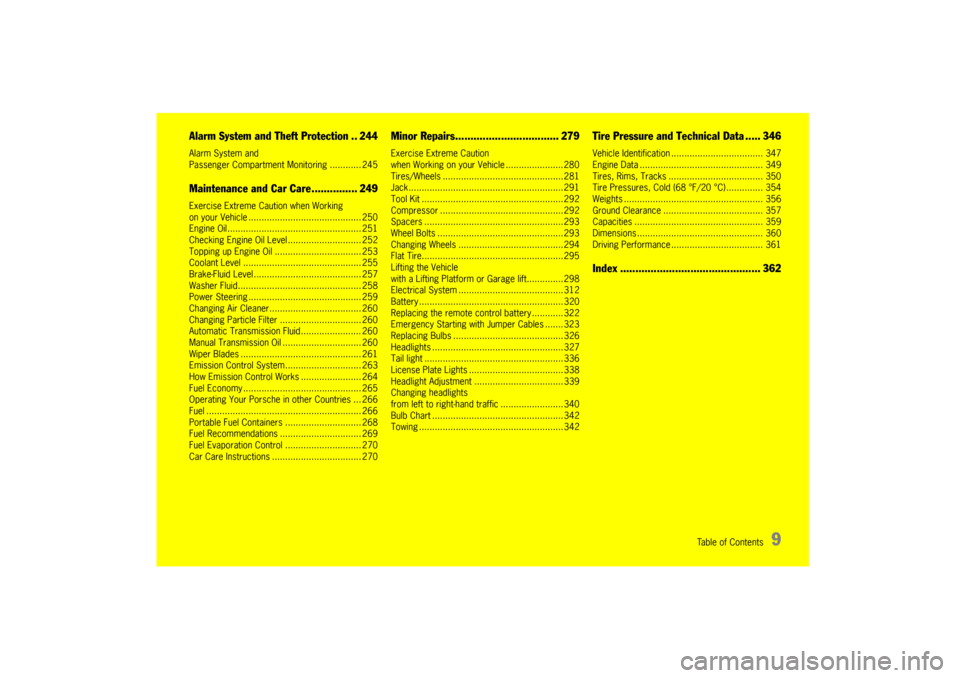
Table of Contents
9
Alarm System and Theft Protection .. 244Alarm System and
Passenger Compartment Monitoring ............ 245Maintenance and Car Care ............... 249Exercise Extreme Caution when Working
on your Vehicle ........................................... 250
Engine Oil................................................... 251
Checking Engine Oil Level............................ 252
Topping up Engine Oil ................................. 253
Coolant Level ............................................. 255
Brake-Fluid Level ......................................... 257
Washer Fluid............................................... 258
Power Steering ........................................... 259
Changing Air Cleaner................................... 260
Changing Particle Filter ............................... 260
Automatic Transmission Fluid....................... 260
Manual Transmission Oil .............................. 260
Wiper Blades .............................................. 261
Emission Control System............................. 263
How Emission Control Works ....................... 264
Fuel Economy ............................................. 265
Operating Your Porsche in other Countries ... 266
Fuel ........................................................... 266
Portable Fuel Containers ............................. 268
Fuel Recommendations............................... 269
Fuel Evaporation Control ............................. 270
Car Care Instructions.................................. 270
Minor Repairs.................................. 279Exercise Extreme Caution
when Working on your Vehicle ......................280
Tires/Wheels ..............................................281
Jack...........................................................291
Tool Kit ......................................................292
Compressor ...............................................292
Spacers .....................................................293
Wheel Bolts ................................................293
Changing Wheels ........................................294
Flat Tire......................................................295
Lifting the Vehicle
with a Lifting Platform or Garage lift..............298
Electrical System ........................................312
Battery .......................................................320
Replacing the remote control battery ............322
Emergency Starting with Jumper Cables .......323
Replacing Bulbs ..........................................326
Headlights ..................................................327
Tail light .....................................................336
License Plate Lights ....................................338
Headlight Adjustment ..................................339
Changing headlights
from left to right-hand traffic ........................340
Bulb Chart ..................................................342
Towing .......................................................342
Tire Pressure and Technical Data ..... 346Vehicle Identification................................... 347
Engine Data ............................................... 349
Tires, Rims, Tracks .................................... 350
Tire Pressures, Cold (68 °F/20 °C) .............. 354
Weights ..................................................... 356
Ground Clearance ...................................... 357
Capacities ................................................. 359
Dimensions ................................................ 360
Driving Performance................................... 361Index .............................................. 362
10_Cayenne_21_KW17.book Seite 9 Donnerstag, 9. April 2009 3:33 15
Page 42 of 379

42
Seats, Mirrors and Steering Wheel
Safety Belts
Danger!
Always make sure your and your passengers'
safety belts are properly fastened while the
vehicle is in motion.
Failure to follow safety belt warnings may re-
sult in serious personal injury or death.
fFor your and your passengers' protection, use
safety belts at all times while the vehicle is in
motion.
fUse appropriate child restraint systems for all
small children.
Proper wearing of safety belts
fS a f e t y b e l t s m u s t b e p o s i t i o n e d o n t h e b o d y a s
to restrain the upper body and lap from sliding
forward. Improperly positioned safety belts
can cause serious personal injury in case of an
accident.
fThe shoulder belt should always rest on your
upper body. The shoulder belt should never be
worn behind your back or under your arm.
fFor maximum effectiveness, the lap belt
should be worn low across the hips.
fPregnant women should position the belt as
low as possible across the pelvis. Make sure it
is not pressing against the abdomen.
fBelts should not be worn twisted.fDo not wear belts over rigid or breakable
objects in or on your clothing, such as eye
glasses, pens, keys, etc. as these may cause
injury.
fSeveral layers of heavy clothing may interfere
with proper positioning of belts.
fBelts must not rub against sharp objects or
damage may occur to the belt.
fTwo occupants should never share the same
belt at the same time.
Care and maintenance
fKeep belt buckles free of any obstruction that
may prevent a secure locking.
fBelts that have been subjected to excessive
stretch forces in an accident must be inspec-
ted or replaced to ensure their continued effec-
tiveness in restraining you.
The same applies to belt tensioner systems
which have been triggered. In addition, the
anchor points of the belts should be checked.
fIf safety belts do not work properly, see your
authorized Porsche dealer immediately.
fI f t h e b e l t s s h o w d a m a g e t o w e b b i n g , b i n d i n g s ,
buckles or retractors, they should be replaced
to ensure safe operation.
fDo not modify or disassemble the safety belts
in your vehicle.fThe belts must be kept clean or the retractors
may not work properly.
Please see the chapter “CAR CARE
INSTRUCTIONS” on Page 270.
fNever bleach or dye safety belts.
fDo not allow safety belts to retract until they
are completely dry after cleaning or this may
cause damage to the belt.
Belt tensionerDepending on the force of a collision, fastened
seat belts are automatically tightened in an
accident.
The belt tensioners are triggered in:
– Front and rear impacts of sufficient severity
– Side impacts (only belt tensioners of the front
seats are triggered)
– In cases of vehicle rollover
10_Cayenne_21_KW17.book Seite 42 Donnerstag, 9. April 2009 3:33 15
Page 43 of 379
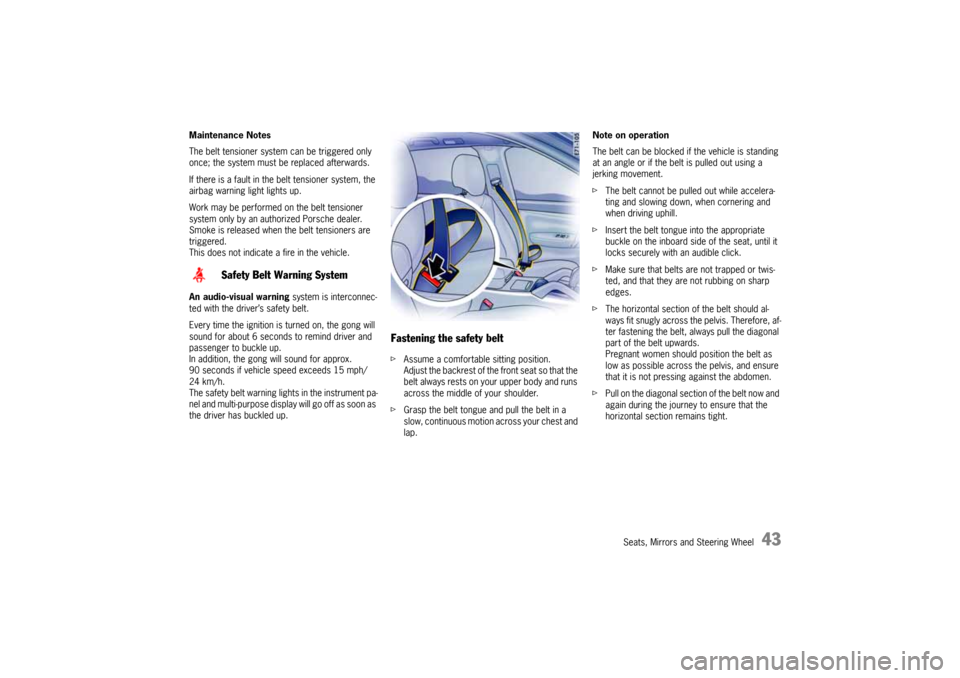
Seats, Mirrors and Steering Wheel
43
Maintenance Notes
The belt tensioner system can be triggered only
once; the system must be replaced afterwards.
If there is a fault in the belt tensioner system, the
airbag warning light lights up.
Work may be performed on the belt tensioner
system only by an authorized Porsche dealer.
Smoke is released when the belt tensioners are
triggered.
This does not indicate a fire in the vehicle.
An audio-visual warning system is interconnec-
ted with the driver’s safety belt.
Every time the ignition is turned on, the gong will
sound for about 6 seconds to remind driver and
passenger to buckle up.
In addition, the gong will sound for approx.
90 seconds if vehicle speed exceeds 15 mph/
24 km/h.
The safety belt warning lights in the instrument pa-
nel and multi-purpose display will go off as soon as
the driver has buckled up.
Fastening the safety beltfAssume a comfortable sitting position.
Adjust the backrest of the front seat so that the
belt always rests on your upper body and runs
across the middle of your shoulder.
fGrasp the belt tongue and pull the belt in a
slow, continuous motion across your chest and
lap.Note on operation
The belt can be blocked if the vehicle is standing
at an angle or if the belt is pulled out using a
jerking movement.
fThe belt cannot be pulled out while accelera-
ting and slowing down, when cornering and
when driving uphill.
fInsert the belt tongue into the appropriate
buckle on the inboard side of the seat, until it
locks securely with an audible click.
fMake sure that belts are not trapped or twis-
ted, and that they are not rubbing on sharp
edges.
fThe horizontal section of the belt should al-
ways fit snugly across the pelvis. Therefore, af-
ter fastening the belt, always pull the diagonal
part of the belt upwards.
Pregnant women should position the belt as
low as possible across the pelvis, and ensure
that it is not pressing against the abdomen.
fPull on the diagonal section of the belt now and
again during the journey to ensure that the
horizontal section remains tight.
Safety Belt Warning System
10_Cayenne_21_KW17.book Seite 43 Donnerstag, 9. April 2009 3:33 15
Page 49 of 379

Seats, Mirrors and Steering Wheel
49
Faults are indicated by a warning light on the
tachometer.
fIn the following cases you should immedi-
ately consult an authorized Porsche
dealer in order to assure the airbag
system is functioning properly:
– If the warning light does not light up when the
ignition is switched on or
– If the warning light does not go out once the
engine is running or
– If the warning light appears while driving.
Airbag maintenanceIn order to ensure long-term functioning, the air-
bag system must be inspected by an authorized
Porsche dealer at the intervals recommended in
your Maintenance Booklet.
Important information
If you sell your Porsche, notify the purchaser that
the vehicle is equipped with airbags, and refer
them to the chapter, “Airbag Systems”, in the
owner's manual (safety and disposal rules).
Further information on the airbag system can be
found on stickers attached to the sun visors, as
well as on all airbag components.
For special recommendations on the use of child
restraints:
fPlease see the chapter “CHILD RESTRAINT
SYSTEMS” on Page 49.
Child Restraint SystemsPorsche recommends that all infants and children
be restrained in child restraint systems at all times
while the vehicle is in motion in accordance with
applicable laws.
fPorsche recommends the use of L.A.T.C.H.
(Lower Anchorage and Tether for Children)
equipped Porsche child seat.
Use only child restraint systems with the LATCH-
system recommended by Porsche. These sys-
tems have been tested and adjusted to the interior
of your Porsche and the appropriate child weight
groups. Other systems have not been tested and
could entail an increased risk of injury.
You can obtain child seats that are LATCH
compatible at your authorized Porsche dealer.
fAlways observe the separate installation
instructions for your child seat.
The use of infant or child restraints is required by
law in all 50 US states and the Canadian provin-
ces. The child restraint system should be one that
complies with U.S. Federal/Canadian Motor Vehic-
le Safety Standards and should be secured by a
lap belt or lap belt portion of a lap-shoulder belt or
for child seats equipped with the LATCH sytem
(Lower Anchorage and Tether for Children, also
known as ISOFIX) to the LATCH anchorages.
A statement by the seat manufacturer of
compliance with this standard can be found on the
instruction label on the restraint and in the
instruction manual provided with the restraint.
Warning light
10_Cayenne_21_KW17.book Seite 49 Donnerstag, 9. April 2009 3:33 15
Page 113 of 379

Lights, Turn Signals and Windshield Wipers
113
5 – Front windshield wipers and washer
system
fPull wiper stalk towards the steering wheel.
The washer system sprays and wipes while the
lever is pulled towards the steering wheel.
When the wiper lever is released, a few wipes
are executed.
Headlight washer (on vehicles with Bi-Xe-
non headlights):
The washer sprays only while low beam or high
beam is switched on.
To activate the headlight washer system, the
wiper lever must be pulled for a longer period
of time.
The headlight washer can be re-activated at
the earliest after five washing cycles.
The spray duration is limited.
Maintenance Note
fIf heavily soiled, repeat wash.
fPersistent dirt (e.g. insect remains) should be
regularly removed.
Please see the chapter “CAR CARE
INSTRUCTIONS” on Page 270.
The front windshield washer nozzles are
heated when the ignition is on, as a precaution
against freezing. However, this does not replace
the use of antifreeze.6 – Rear window wiper – intermittent
operation
fMove wiper stalk forwards to the first click.
The rear window wiper wipes at preset
intervals.
7 – Rear window wiper – one-touch
operation
fPush wiper stalk forward briefly. The washer
system sprays and the rear window wiper goes
through three wipe cycles.
Rear window wiper and washer system
fPush wiper stalk forwards as far as it will go.
The washer system sprays and wipes while the
lever is pulled away from the steering wheel.
When the wiper lever is released, a few drying
wipes are executed.Maintenance Note
fPeriodically clean the wiper blades with
window cleaner, especially after the vehicle
has been washed in a car wash.
We recommend the Porsche window cleaner.
In the event of heavy soiling (e.g. insect
residue), the blades can be cleaned with a
sponge or a cloth.
If the wiper blades rub or squeak, this may have
the following causes:
– If the vehicle is washed in an automatic car
wash, wax residues may adhere to the wind-
shield. These wax residues can be removed
only by using window cleaner concentrate.
fPlease see the chapter “WASHER FLUID” on
Page 258.
fPlease contact your authorized Porsche dealer
for further information.
– The wiper blades may be damaged or worn.
fReplace damaged or worn wiper blades as
soon as possible.
10_Cayenne_21_KW17.book Seite 113 Donnerstag, 9. April 2009 3:33 15
Page 132 of 379
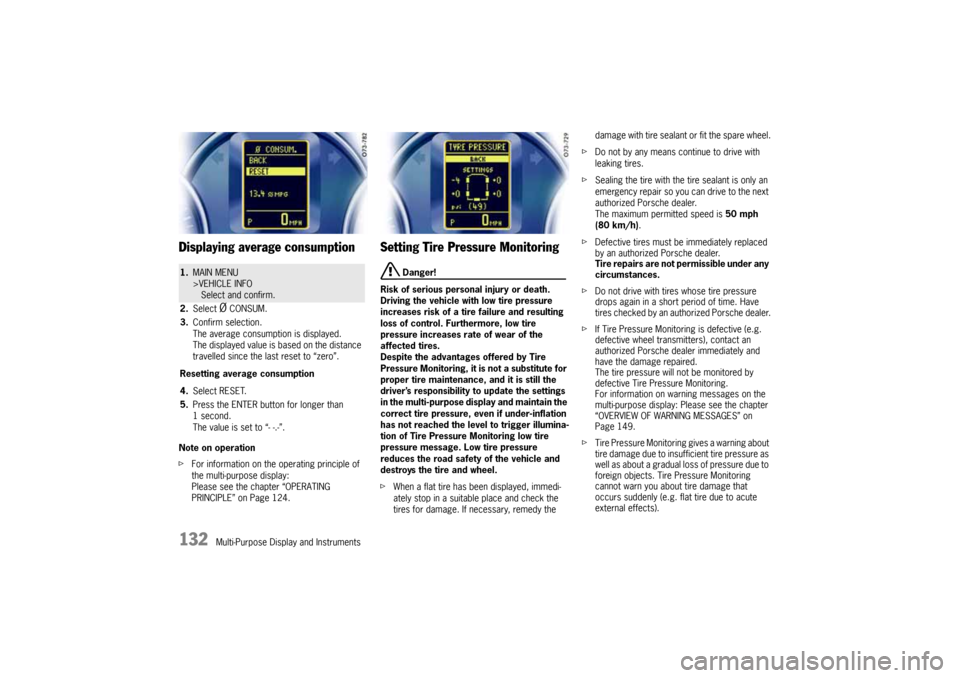
132
Multi-Purpose Display and Instruments
Displaying average consumptionNote on operation
fFor information on the operating principle of
the multi-purpose display:
Please see the chapter “OPERATING
PRINCIPLE” on Page 124.
Setting Tire Pressure Monitoring
Danger!
Risk of serious personal injury or death.
Driving the vehicle with low tire pressure
increases risk of a tire failure and resulting
loss of control. Furthermore, low tire
pressure increases rate of wear of the
affected tires.
Despite the advantages offered by Tire
Pressure Monitoring, it is not a substitute for
proper tire maintenance, and it is still the
driver’s responsibility to update the settings
in the multi-purpose display and maintain the
correct tire pressure, even if under-inflation
has not reached the level to trigger illumina-
tion of Tire Pressure Monitoring low tire
pressure message. Low tire pressure
reduces the road safety of the vehicle and
destroys the tire and wheel.
fWhen a flat tire has been displayed, immedi-
ately stop in a suitable place and check the
tires for damage. If necessary, remedy the damage with tire sealant or fit the spare wheel.
fDo not by any means continue to drive with
leaking tires.
fSealing the tire with the tire sealant is only an
emergency repair so you can drive to the next
authorized Porsche dealer.
The maximum permitted speed is 50 mph
(80 km/h).
fDefective tires must be immediately replaced
by an authorized Porsche dealer.
Tire repairs are not permissible under any
circumstances.
fDo not drive with tires whose tire pressure
drops again in a short period of time. Have
tires checked by an authorized Porsche dealer.
fIf Tire Pressure Monitoring is defective (e.g.
defective wheel transmitters), contact an
authorized Porsche dealer immediately and
have the damage repaired.
The tire pressure will not be monitored by
defective Tire Pressure Monitoring.
For information on warning messages on the
multi-purpose display: Please see the chapter
“OVERVIEW OF WARNING MESSAGES” on
Page 149.
fTire Pressure Monitoring gives a warning about
tire damage due to insufficient tire pressure as
well as about a gradual loss of pressure due to
foreign objects. Tire Pressure Monitoring
cannot warn you about tire damage that
occurs suddenly (e.g. flat tire due to acute
external effects).
1.MAIN MENU
>VEHICLE INFO
Select and confirm.
2.Select
Ø CONSUM.
3.Confirm selection.
The average consumption is displayed.
The displayed value is based on the distance
travelled since the last reset to “zero”.
Resetting average consumption
4.Select RESET.
5.Press the ENTER button for longer than
1second.
The value is set to “- -.-”.
10_Cayenne_21_KW17.book Seite 132 Donnerstag, 9. April 2009 3:33 15
Page 142 of 379
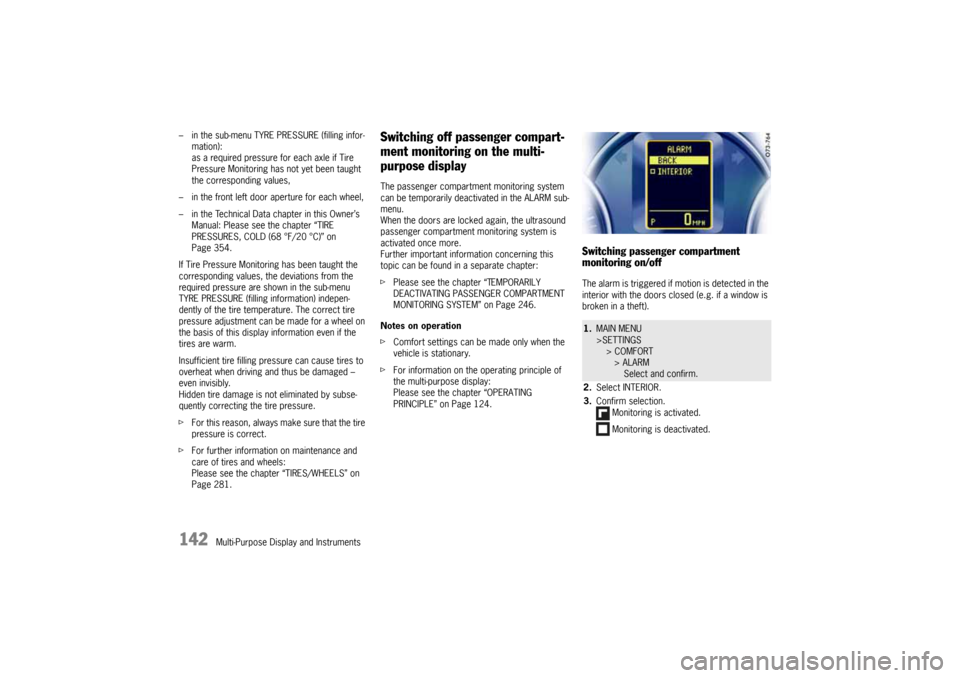
142
Multi-Purpose Display and Instruments – in the sub-menu TYRE PRESSURE (filling infor-
mation):
as a required pressure for each axle if Tire
Pressure Monitoring has not yet been taught
the corresponding values,
– in the front left door aperture for each wheel,
– in the Technical Data chapter in this Owner’s
Manual: Please see the chapter “TIRE
PRESSURES, COLD (68 °F/20 °C)” on
Page 354.
If Tire Pressure Monitoring has been taught the
corresponding values, the deviations from the
required pressure are shown in the sub-menu
TYRE PRESSURE (filling information) indepen-
dently of the tire temperature. The correct tire
pressure adjustment can be made for a wheel on
the basis of this display information even if the
tires are warm.
Insufficient tire filling pressure can cause tires to
overheat when driving and thus be damaged –
even invisibly.
Hidden tire damage is not eliminated by subse-
quently correcting the tire pressure.
fFor this reason, always make sure that the tire
pressure is correct.
fFor further information on maintenance and
care of tires and wheels:
Please see the chapter “TIRES/WHEELS” on
Page 281.
Switching off passenger compart-
ment monitoring on the multi-
purpose displayThe passenger compartment monitoring system
can be temporarily deactivated in the ALARM sub-
menu.
When the doors are locked again, the ultrasound
passenger compartment monitoring system is
activated once more.
Further important information concerning this
topic can be found in a separate chapter:
fPlease see the chapter “TEMPORARILY
DEACTIVATING PASSENGER COMPARTMENT
MONITORING SYSTEM” on Page 246.
Notes on operation
fComfort settings can be made only when the
vehicle is stationary.
fFor information on the operating principle of
the multi-purpose display:
Please see the chapter “OPERATING
PRINCIPLE” on Page 124.
Switching passenger compartment
monitoring on/offThe alarm is triggered if motion is detected in the
interior with the doors closed (e.g. if a window is
broken in a theft).1.MAIN MENU
>SETTINGS
> COMFORT
> ALARM
Select and confirm.
2.Select INTERIOR.
3.Confirm selection.
Monitoring is activated.
Monitoring is deactivated.
10_Cayenne_21_KW17.book Seite 142 Donnerstag, 9. April 2009 3:33 15
Page 153 of 379
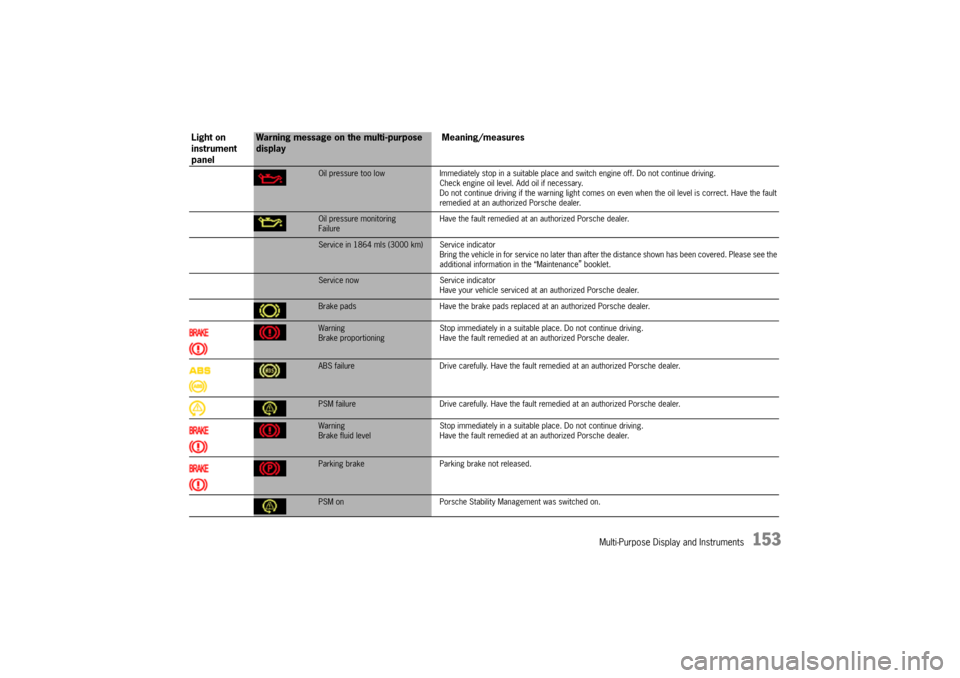
Multi-Purpose Display and Instruments
153
Oil pressure too low Immediately stop in a suitable place and switch engine off. Do not continue driving.
Check engine oil level. Add oil if necessary.
Do not continue driving if the warning light comes on even when the oil level is correct. Have the fault
remedied at an authorized Porsche dealer.Oil pressure monitoring
FailureHave the fault remedied at an authorized Porsche dealer.Service in 1864 mls (3000 km) Service indicator
Bring the vehicle in for service no later than after the distance shown has been covered. Please see the
additional information in the “Maintenance
” booklet.
Service now Service indicator
Have your vehicle serviced at an authorized Porsche dealer.Brake pads Have the brake pads replaced at an authorized Porsche dealer.Warning
Brake proportioningStop immediately in a suitable place. Do not continue driving.
Have the fault remedied at an authorized Porsche dealer.ABS failure Drive carefully. Have the fault remedied at an authorized Porsche dealer.PSM failure Drive carefully. Have the fault remedied at an authorized Porsche dealer.Warning
Brake fluid levelStop immediately in a suitable place. Do not continue driving.
Have the fault remedied at an authorized Porsche dealer.Parking brake Parking brake not released.PSM on Porsche Stability Management was switched on.
Light on
instrument
panel
Warning message on the multi-purpose
displayMeaning/measures
10_Cayenne_21_KW17.book Seite 153 Donnerstag, 9. April 2009 3:33 15
Page 165 of 379
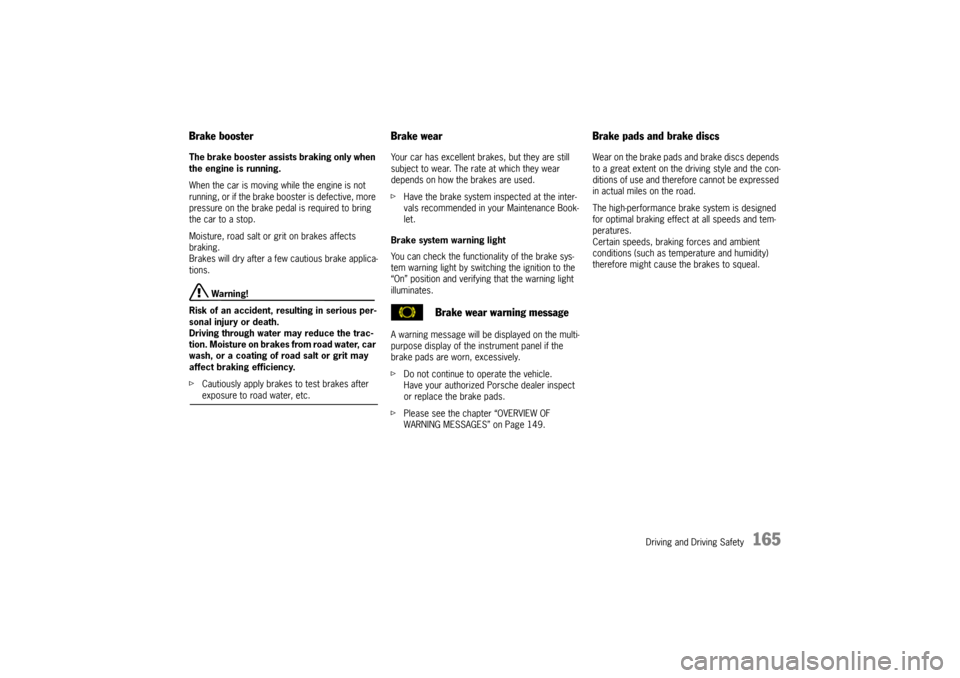
Driving and Driving Safety
165
Brake boosterThe brake booster assists braking only when
the engine is running.
When the car is moving while the engine is not
running, or if the brake booster is defective, more
pressure on the brake pedal is required to bring
the car to a stop.
Moisture, road salt or grit on brakes affects
braking.
Brakes will dry after a few cautious brake applica-
tions.
Warning!
Risk of an accident, resulting in serious per-
sonal injury or death.
Driving through water may reduce the trac-
tion. Moisture on brakes from road water, car
wash, or a coating of road salt or grit may
affect braking efficiency.
fCautiously apply brakes to test brakes after exposure to road water, etc.
Brake wearYour car has excellent brakes, but they are still
subject to wear. The rate at which they wear
depends on how the brakes are used.
fHave the brake system inspected at the inter-
vals recommended in your Maintenance Book-
let.
Brake system warning light
You can check the functionality of the brake sys-
tem warning light by switching the ignition to the
“On” position and verifying that the warning light
illuminates.
A warning message will be displayed on the multi-
purpose display of the instrument panel if the
brake pads are worn, excessively.
fDo not continue to operate the vehicle.
Have your authorized Porsche dealer inspect
or replace the brake pads.
fPlease see the chapter “OVERVIEW OF
WARNING MESSAGES” on Page 149.
Brake pads and brake discsWear on the brake pads and brake discs depends
to a great extent on the driving style and the con-
ditions of use and therefore cannot be expressed
in actual miles on the road.
The high-performance brake system is designed
for optimal braking effect at all speeds and tem-
peratures.
Certain speeds, braking forces and ambient
conditions (such as temperature and humidity)
therefore might cause the brakes to squeal.
Brake wear warning message
10_Cayenne_21_KW17.book Seite 165 Donnerstag, 9. April 2009 3:33 15